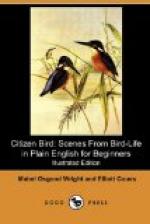The next morning was clear and warm, and the children tumbled out in their flannel bathing-suits to have a dip before breakfast. Rap, by rolling over and over on the sand, was in the water as soon as Nat; but they did not venture out far, even though the tide was low, contenting themselves by splashing about in shallow places.
[Illustration: Turnstone.]
Presently Nat spied something on the stony end of the bar that stretched out at the right of the beach, and pointed it out to Rap, who said: “They are some sort of birds: you had better get the glass, for even if we could go nearer to them, they would be sure to see us and skip.” Then Nat brought the glass and they each took a peep.
“The bodies are like speckled Pullets’, but the heads are like Pigeons’ and the legs are very thin,” said Rap. “See! there is a different one, ever so much nearer over on this side, but I can’t make him out very well. Here comes the Doctor, all ready to go in swimming; of course he can tell us.”
“Those mottled birds with red legs are Turnstones,” said the Doctor, after looking a moment. “They are wading shore birds, who run about the rock bars and sandy beaches, turning over small stones for the food that is hidden underneath. They very seldom come into bays like this, but keep more on the outer beaches. The other one, with black under parts and dark back finely speckled with yellow, is the Golden Plover, who often visits our beaches and marshy meadows.”
“Do either of them ever nest up the river?” asked Dodo.
“No, indeed—you would have to travel many hundreds of miles to find the lonely Arctic beaches they both call home. They only come this way before they take the long fall journey to South America, where they winter; and in the spring-time they are usually in too great a hurry to stop.”
“What do they look like very near by?” asked Dodo, who always wanted details, while the boys took a more general sportsmanlike interest.
[Illustration: American Golden Plover.]
“The Turnstone is very trim and pretty when seen close at hand, and from the pattern of the feathers is often called Calico-bird. The Golden Plover is darker and not so conspicuously marked, especially at this season.”
The Turnstone
Length nine and a half inches.
In summer: Upper parts boldly variegated with black, white, and reddish-brown; tail black, with white base and tip. Under parts white, with large black marks on the breast. Bill and eyes black; feet orange, with a very small hind toe. In winter: Without the bright, reddish-brown markings, which are gray; and with not so much black, which is also duller.
A Citizen of North America, making its summer home only in the Arctic regions, but at other seasons travelling almost all over the world; we see it mostly when it is migrating, in spring and fall, along the sea-coast.




